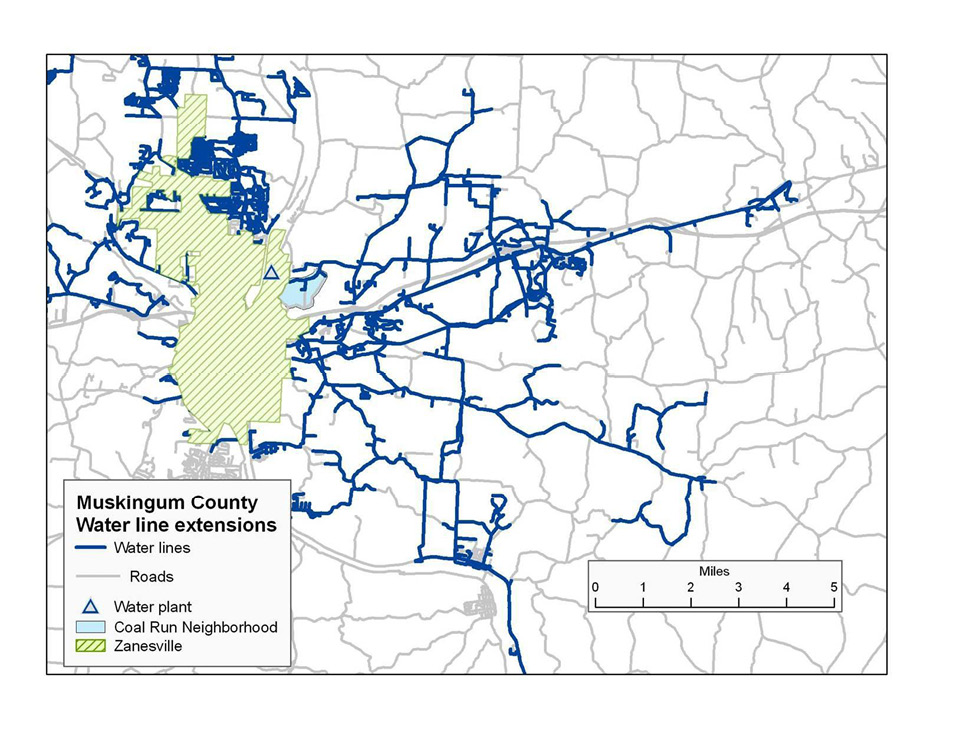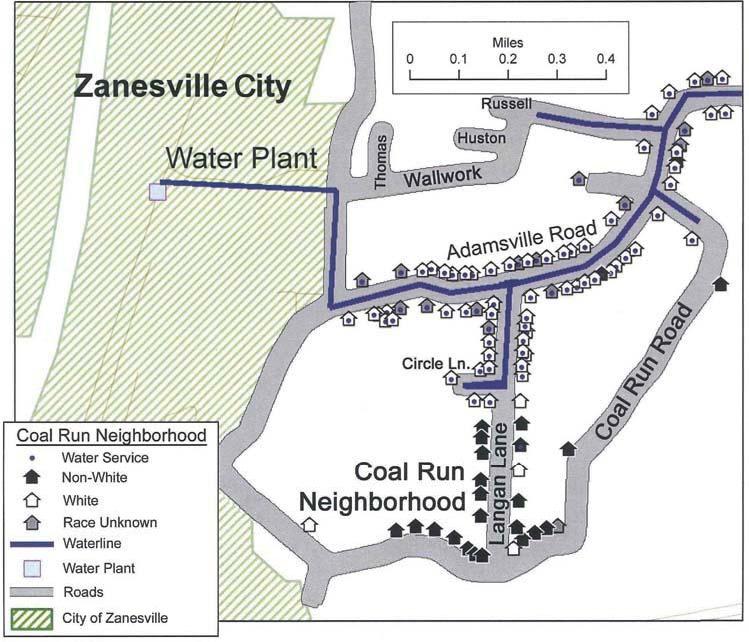The Global Impact of Open Data
Kennedy vs. the City of Zanesville, United States
Open Data as evidence
by Christina Rogawski, Stefaan Verhulst and Andrew Young*
Reference
2 "Kennedy v. City of Zanesville." Relman, Dane & Colfax PLLC. http://www.relmanlaw.com/civil-rights-litigation/cases/zanesville.php
3 Johnson, Dirk. "For a Recently Plumbed Neighborhood, Validation in a Verdict." The New York Times, August 11, 2008. http://www.nytimes.com/2008/08/12/us/12ohio.html?_r=0.
4 Parnell, Allan M. “Maps Used in Support of the Plaintiff’s Argument in Kennedy et al. v. City of Zanesville, et al.” Legal Services of Northern California Race Equity Project. August 6, 2008. http://equity.lsnc.net/2008/08/maps-used-in-support-of-the-plaintiff%E2%80%99s-arguement-in-kennedy-et-al-v-city-of-zanesville-et-al/
5 GovLab interview with Tara Ramchandani, Attorney, Relman, Dane, & Colfax PLLC, August 3, 2015.
6 Johnson, Dirk. "For a Recently Plumbed Neighborhood, Validation in a Verdict." The New York Times, August 11, 2008. http://www.nytimes.com/2008/08/12/us/12ohio.html?_r=0.
7 GovLab interview with Tara Ramchandani, Attorney, Relman, Dane, & Colfax PLLC, August 3, 2015.
8 Johnson, Dirk. "For a Recently Plumbed Neighborhood, Validation in a Verdict." The New York Times, August 11, 2008. http://www.nytimes.com/2008/08/12/us/12ohio.html?_r=0.
9 "Kennedy v. City of Zanesville." Relman, Dane & Colfax PLLC. http://www.relmanlaw.com/civil-rights-litigation/cases/zanesville.php
13 GovLab interview with Allan Parnell, Ph.D., Vice President, Cedar Grove Institute for Sustainable Communities, October 2, 2015.
14 GovLab interview with Allan Parnell, Ph.D., Vice President, Cedar Grove Institute for Sustainable Communities, July 21, 2015.
15 GovLab interview with Allan Parnell, Ph.D., Vice President, Cedar Grove Institute for Sustainable Communities, July 21, 2015.
16 Parnell, Allan M. “Maps Used in Support of the Plaintiff’s Argument in Kennedy et al. v. City of Zanesville, et al.” Legal Services of Northern California Race Equity Project. August 6, 2008. http://equity.lsnc.net/2008/08/maps-used-in-support-of-the-plaintiff%E2%80%99s-arguement-in-kennedy-et-al-v-city-of-zanesville-et-al/
17 Parnell, Allan M. “Maps Used in Support of the Plaintiff’s Argument in Kennedy et al. v. City of Zanesville, et al.” Legal Services of Northern California Race Equity Project. August 6, 2008. http://equity.lsnc.net/2008/08/maps-used-in-support-of-the-plaintiff%E2%80%99s-arguement-in-kennedy-et-al-v-city-of-zanesville-et-al/
18 GovLab interview with Allan Parnell, Ph.D., Vice President, Cedar Grove Institute for Sustainable Communities, July 21, 2015.
19 “What is GIS?” ESRI. http://www.esri.com/what-is-gis/howgisworks
20 GovLab interview with Allan Parnell, Ph.D., Vice President, Cedar Grove Institute for Sustainable Communities, July 21, 2015.
21 Parnell, Allan M. “Maps Used in Support of the Plaintiff’s Argument in Kennedy et al. v. City of Zanesville, et al.” Legal Services of Northern California Race Equity Project. August 6, 2008. http://equity.lsnc.net/2008/08/maps-used-in-support-of-the-plaintiff%E2%80%99s-arguement-in-kennedy-et-al-v-city-of-zanesville-et-al/
22 Parnell, Allan M. “Maps Used in Support of the Plaintiff’s Argument in Kennedy et al. v. City of Zanesville, et al.” Legal Services of Northern California Race Equity Project. August 6, 2008. http://equity.lsnc.net/2008/08/maps-used-in-support-of-the-plaintiff%E2%80%99s-arguement-in-kennedy-et-al-v-city-of-zanesville-et-al/
23 Parnell, Allan M. “Maps Used in Support of the Plaintiff’s Argument in Kennedy et al. v. City of Zanesville, et al.” Legal Services of Northern California Race Equity Project. August 6, 2008. http://equity.lsnc.net/2008/08/maps-used-in-support-of-the-plaintiff%E2%80%99s-arguement-in-kennedy-et-al-v-city-of-zanesville-et-al/
24 GovLab interview with Allan Parnell, Ph.D., Vice President, Cedar Grove Institute for Sustainable Communities, July 21, 2015.
25 GovLab interview with Allan Parnell, Ph.D., Vice President, Cedar Grove Institute for Sustainable Communities, July 21, 2015.
26 “Kennedy v. City of Zanesville.” Relman, Dane & Colfax PLLC. http://www.relmanlaw.com/civil-rights-litigation/cases/zanesville.php
27 “Kennedy v. City of Zanesville.” Relman, Dane & Colfax PLLC. http://www.relmanlaw.com/civil-rights-litigation/cases/zanesville.php
29 Badger, Emily. “Obama administration to unveil major new rules targeting segregation across U.S.” The Washington Post. July 8, 2015. http://www.washingtonpost.com/news/wonkblog/wp/2015/07/08/obama-administration-to-unveil-major-new-rules-targeting-segregation-across-u-s/
30 “Expert Witness Work.” Cedar Grove Institute for Sustainable Communities. http://www.cedargroveinst.org/partners.php
31 GovLab interview with Allan Parnell, Ph.D., Vice President, Cedar Grove Institute for Sustainable Communities, July 21, 2015.
32 GovLab interview with Tara Ramchandani, Attorney, Relman, Dane, & Colfax PLLC, August 3, 2015.
33 Badger, Emily. “Obama administration to unveil major new rules targeting segregation across U.S.” The Washington Post. July 8, 2015. http://www.washingtonpost.com/news/wonkblog/wp/2015/07/08/obama-administration-to-unveil-major-new-rules-targeting-segregation-across-u-s/
34 GovLab interview with Allan Parnell, Ph.D., Vice President, Cedar Grove Institute for Sustainable Communities, October 2, 2015.
35 GovLab interview with Allan Parnell, Ph.D., Vice President, Cedar Grove Institute for Sustainable Communities, October 2, 2015.
36 GovLab interview with Allan Parnell, Ph.D., Vice President, Cedar Grove Institute for Sustainable Communities, July 21, 2015.
37 GovLab interview with Allan Parnell, Ph.D., Vice President, Cedar Grove Institute for Sustainable Communities, July 21, 2015.
38 GovLab interview with Tara Ramchandani, Attorney, Relman, Dane, & Colfax PLLC, August 3, 2015.
39 GovLab interview with Tara Ramchandani, Attorney, Relman, Dane, & Colfax PLLC, August 3, 2015.
40 GovLab interview with Allan Parnell, Ph.D., Vice President, Cedar Grove Institute for Sustainable Communities, July 21, 2015.
41 GovLab interview with Allan Parnell, Ph.D., Vice President, Cedar Grove Institute for Sustainable Communities, July 21, 2015.
42 GovLab interview with Tara Ramchandani, Attorney, Relman, Dane, & Colfax PLLC, August 3, 2015.
43 GovLab interview with Tara Ramchandani, Attorney, Relman, Dane, & Colfax PLLC, August 3, 2015.
44 Johnson, Dirk. “For a Recently Plumbed Neighborhood, Validation in a Verdict.” The New York Times, August 11, 2008. http://www.nytimes.com/2008/08/12/us/12ohio.html?_r=0.
45 “Society boosts DataOhio legislation.” The Ohio Society of CPAs. May 20, 2015. http://www.ohiocpa.com/utilities/displaynewsitem/2015/05/21/society-boosts-dataohio-legislation




